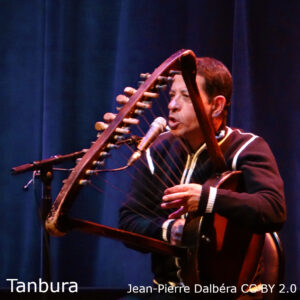In this post, I explore the sense of place that music can evoke. When I listen to Middle Eastern belly dance music, I don’t usually think too hard about the locality it comes from. But in this YouTube video of musicians from Port Said playing on the beach, I feel a strong sense of place.
Port Said Music
A group of folk musicians from Port Said sing and dance in the video. When we think of Egypt, we often think of its culture as stemming from Pharaonic times. But there are other aspects of its rich culture. Port Said is a city on the mouth of the Suez Canal on the Mediterranean coast of Egypt. It dates from the building of the canal in the 1800s. It has a distinct culture reflecting its desert surroundings fused with its cosmopolitan seafaring community.
The simsimiyya and tanbura are part of Port Said’s unique culture. They are both types of lyre, a harp-like string instruments originating in Ancient Greece. It spread across Europe and the Middle East and beyond. The simsimiyya was commonly found in coastal Bedouin desert communities across North Africa. From there, the musicians of Port Said adapted it. The simsimiyya and tanbura are very similar. The main difference is that the simsimiyya is simpler, with fewer strings and no tuning pegs. The tanbura features tuning pegs and additional strings which allow it to play Arabic musical modes (maqamat) more easily.

The typical simsimiyya folk group contains a mix of musicians. It includes specialist simsimiyya/tanbura players and a chorus group. The chorus provides the rhythmic accompaniment. It consists of a tabla or two, a riqq, toura (finger cymbals) plus handclapping, singing, and dancing. The musicians and instrumentation are flexible. They swap instruments frequently and take turns getting up to dance.
Evoking a Sense of Place
The relaxed, informal, yet powerful music reflects the cultural context of Port Said. It is very much folk music as lived experience. For example, many songs are about the 1956 Suez crisis when the Egyptian President Nasser nationalised the Suez canal. Performances capture the informal café culture of the city. Men sing and dance in a relaxed atmosphere. You can see that in the video. Scenes of the city and the sea are interspersed with the musicians casually singing and dancing on the beach.
For me, the simsimiyya and the folk music of Port Said have a strong sense of place and meaning tied to its locality. This is quite different to how I usually think of belly dance music. I typically select a piece of music I like. Then I try to stylistically represent the genre (baladi, pop, shaabi, etc.) when I’m dancing. But I don’t think about the sense of place and where the music has come from. Next time you put on a piece of music and dance, why not ask yourself ‘Where is this music from? How does its sense of place sound? How does that influence my dancing?’.
Sources
El Tanbura (Wikipedia). https://en.wikipedia.org/wiki/El_Tanbura
La Simsimyya de Port-Said (CD review). https://www.umbc.edu/MA/index/number7/stokes/simsi.htm
A man, a plan, a canal … a band (newspaper article). https://www.theguardian.com/music/2006/oct/20/worldmusic
El Tanbura band (Facebook page). https://www.facebook.com/el.tanbura.official
